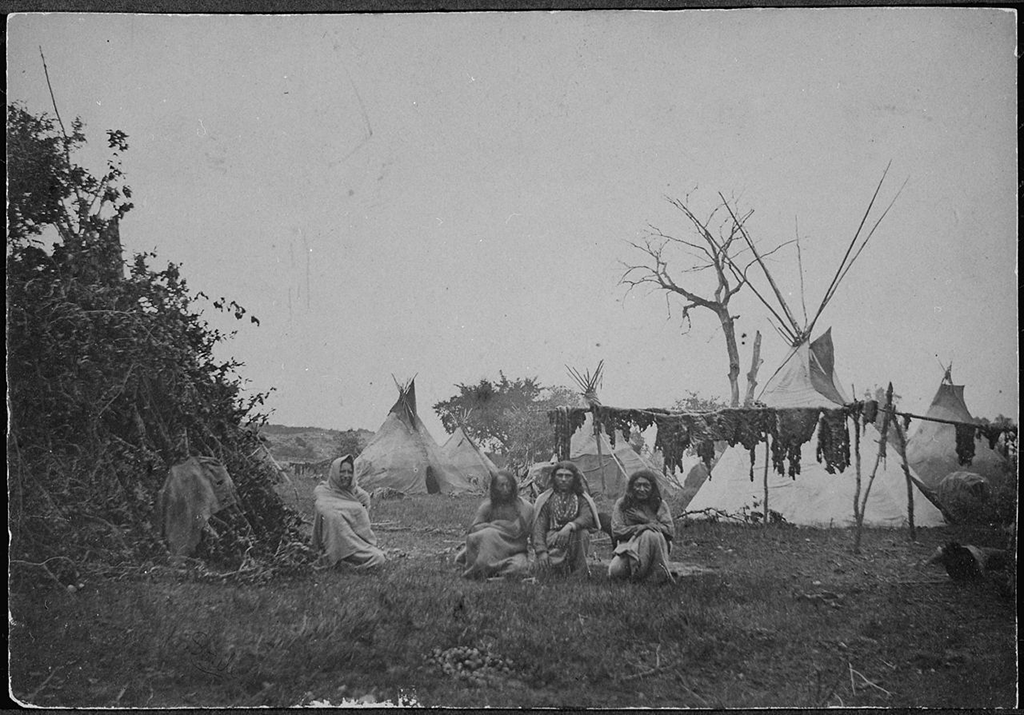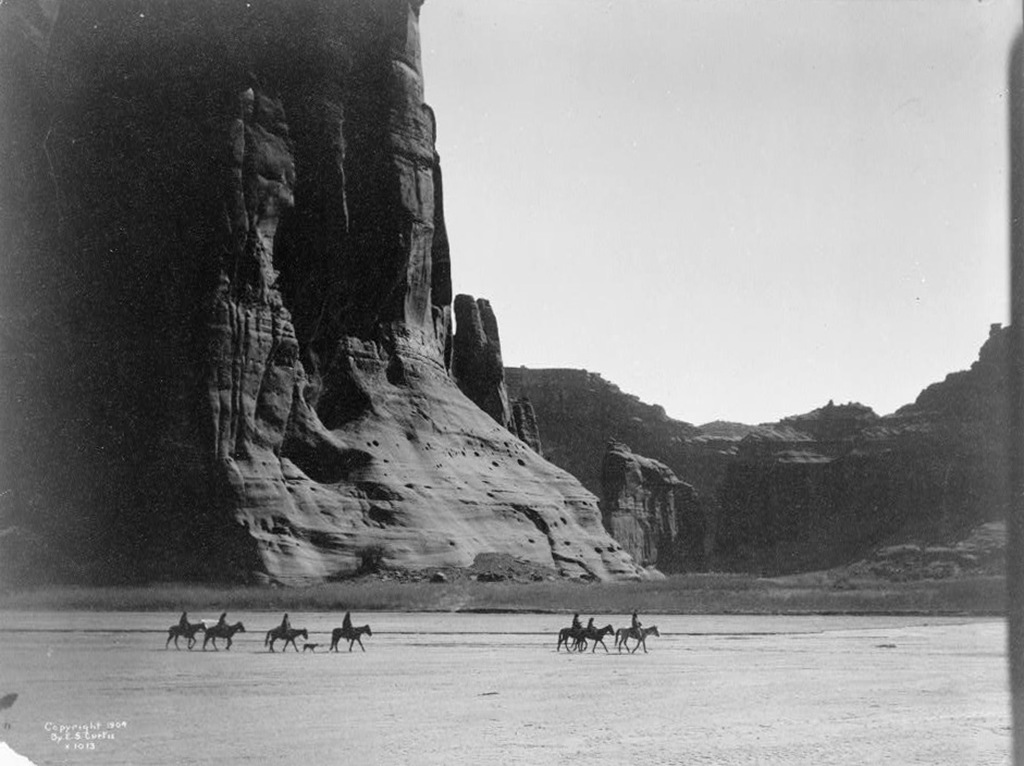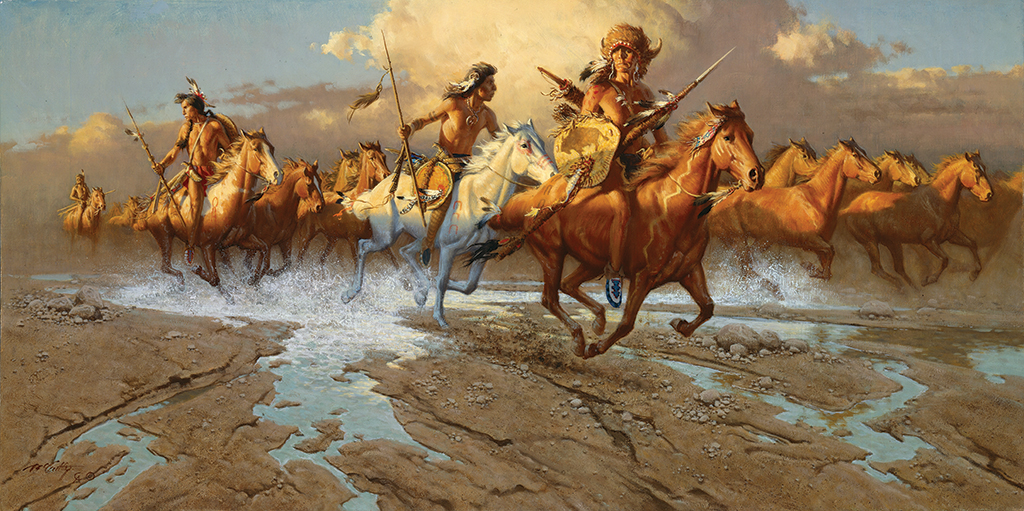Intertwined with the histories of the shaky state of the Mexican government, the Santa Fe Trade, and U.S. efforts to expand to the Pacific Ocean was the story of Comanche and Apache dominance of the borderlands. Even as the Santa Fe Trade was established, people on all sides of it had to recognize the place of independent indigenous peoples as they moved their goods. William Becknell’s inaugural trading party was greeted by a battalion of nuevomexicanos under Captain Pedro Ignacio Gallego, known as the Urban Militia from Abiquiú. Gallego and his men, augmented by a group of Pueblo auxiliaries (unnumbered in the historical record, as was typical), campaigned in search of Navajo warriors who recently captured cattle in northern New Mexican settlements. As Gallego’s convoy headed eastward in pursuit, they encountered six strangers at a point just to the south of Las Vegas. The six men turned out to be Becknell and his companions, and, after a few tense moments, the soldiers welcomed them into the department.
As Comanches and Apaches reinvigorated their raids on Mexican settlements in the north following Mexican independence and the opening of the Santa Fe Trade, old cycles of retributive violence once again came to dominate the region. Such was especially the case in Chihuahua and Sonora, although native-Mexican feuds also increased in Coahuila y Texas, New Mexico, Tamaulipas, and places as far south as Durango. The overall trend toward violent raids and warfare has been characterized by historian Brian DeLay as the War of a Thousand Deserts. Mexican participants in the conflicts, as well as Mexican political officials, soon realized that the escalating campaigns by peoples who they deemed indios bárbaros had resulted in the creation of “man-made deserts where there had been thriving Mexican settlements.” As DeLay explains, “in this context the term [desert] referred not to aridity, but to emptiness, silence, fruitlessness, desolation, to the absence of industry and improvement and of human mastery over nature.”10
From the Mexican perspective, Comanches and Apaches were actively turning back the clock of civilization in the north. One Chihuahua observer noted that indigenous raids had “destroyed the haciendas, the temples, the cities, all the work and glory of many generations, in order to recreate the desert which the Apache eye delights in.” The Mexican War Minister also used the term “immense deserts” to describe northern settlements that had been devastated and depopulated due to Comanche and Apache raiding.11

To further contextualize the violence, Mexican independence had nominally altered the relationship of nomadic peoples to the nation. Under Spanish colonial systems, those indigenous peoples who were not subjugated to the Crown were considered apart from society. The liberal ideals underlying the Constitution of 1824, however, espoused full inclusion in Mexican citizenship by all who had been born within the confines of the territory claimed by the nation. On paper, this meant that Comanche, Apache, Ute, and Navajo people were Mexican citizens—whether they wished to be or not. In practice, those people continued to exercise their autonomy, as all too clearly evidenced by the renewed attacks that defined the War of a Thousand Deserts.
New Mexico was spared the worst of the bloody conflicts with Comanches and Apaches, who primarily targeted Chihuahua and Sonora. Even in New Mexico, however, nomadic peoples acted on their growing hatred of Mexicans, who, from their perspective, had broken earlier agreements and perpetrated injustices upon them. When Sylvester and James O. Pattie encountered Chihenne Apaches in the region of the Gila River and Santa Rita Mines in the 1820s, for example, the Chihenne apologized for attacking the father-son team because they had mistaken them for Mexicans. Chihenne warriors told James that their hatred for Mexicans ran deep because they were devious and conniving in their dealings with Apache peoples. On one occasion, Mexican settlers had lured Apache negotiators into their town under the pretext of creating a peace settlement. Instead, as the Chihenne recounted to Pattie, the Mexicans “commenced butchering them like a flock of sheep.”12 Such atrocities occurred on both sides and only deepened the violent blood feuds that rocked northern Mexico between the late 1820s and 1840s.
In New Mexico, the redefined status of Pueblo peoples and increased Navajo raids also marked the Mexican period. The definition of citizenship espoused in the Constitution of 1824 ended former protections afforded the Pueblos by the Spanish Crown. As was also the case with later liberal reforms during La Reforma in Mexico, well-intentioned legislative changes had an adverse impact on indigenous peoples’ ability to maintain traditional communal landholding practices. Under the 1824 constitution, Pueblo sovereignty was no longer recognized and the result was widespread land dispossession. Corrupt officials used the Pueblos’ new status as fellow citizens with the right to buy and sell their lands as a pretext to sell pieces of Pueblo lands out from under their traditional owners. Falsified documentation and fraudulent land titles facilitated the land grab.
In most ways the Mexican government ignored Pueblo peoples and their plight. Yet that lack of attention also allowed them to renew their traditional rites and ceremonies with new vigor. Despite land loss, which was not as pronounced as it later became under U.S. rule, Pueblos “planted their corn, harvested their crops, worried about the water supply, and maintained traditional family life.” They strengthened Clan connections and their “ancient customs began to take on new life.”13
As Navajo raids intensified, however, Pueblos were not exempted from the militia drafts that placed great burdens on all poor nuevomexicanos. In the 1830s, approximately 7,000 Navajo people inhabited their traditional homeland to the west of New Mexican settlements. The Diné were a semi-sedentary people who relied on a combination of hunting, gathering, agricultural production, and sheepherding for their livelihood. Their social and political organization was always confusing to nuevomexicanos (and it would also perplex later American administrators). Most of the time, Navajos resided in small extended family groups, but matters of grave importance, like raiding, warfare, and some large-scale trade dealings, brought the smaller family groups together to make decisions. In rare occasions, a naach’id (extended tribal council) brought together representatives from across the Dinétah. This fluid social and political structure frustrated New Mexicans and Americans who wished to negotiate trade or peace treaties with Navajo peoples.

As the War of a Thousand Deserts resulted in heightened tensions and conflicts between Apaches, Comanches, and Mexican settlers in the northern states of Chihuahua, Coahuila y Texas, and Sonora, in New Mexico the erosion of peace meant seemingly constant campaigns against the Navajos. The central government refused to support northerners’ attempts to alternately make war against and forge peace with indigenous peoples, so regional leaders took matters into their own hands. During the 1820s and 1830s, New Mexican governors regularly called local settlers to militia service against the Diné.
The province’s empty coffers meant that participation in the militia offered no outfitting or pay to the poverty-stricken mestizo, Pueblo, and genízaro men who comprised its rank and file. They brought along their own food, supplies, and weapons—often bows and arrows or outdated and ill-maintained rifles. If they were lucky, raids on Navajo herds and fields would allow them a small profit for their service. More often, however, they returned from the field physically, emotionally, and economically exhausted. Adding insult to injury, many servicemen filed complaints about harsh treatment at the hands of their rico commanders. When President Santa Anna implemented new centralizing measures in 1835 and 1836, some nuevomexicanos were hopeful that they would include new funds to carry out campaigns against the Navajos.
Unfortunately for nuevomexicanos, such was not the case. As violence continued to escalate throughout the north, Mexico City officials continued to refuse reinforcement or other support to Mexican settlers there. Governors, presidio captains, and other regional leaders sent a steady stream of correspondence to the capital in the 1830s and 1840s that generally went unheeded. When responses did arrive, they were generally condescending. In 1836, the Minister of War dismissed one such appeal from Chihuahua by reminding northerners that “Indians don’t unmake presidents.”14 Over the next few years, as the War of a Thousand Deserts was compounded by war against the United States, he was proven wrong
